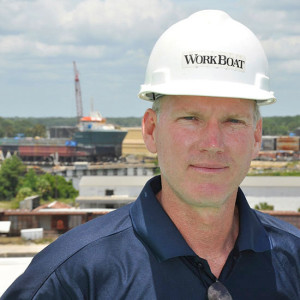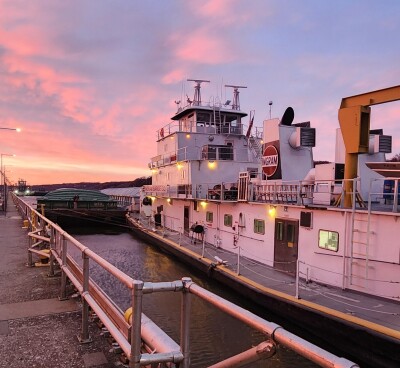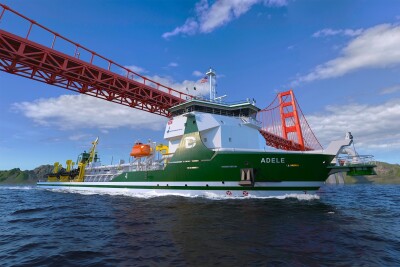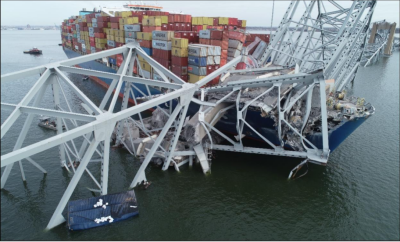The National Transportation Safety Board (NTSB) released the report of its investigation of the May 2018 allision of the towing vessel Steve Richoux on the Lower Mississippi River at New Orleans.
On May 7, 2018, the 1,800-hp Steve Richoux with five crewmembers on board was downbound on the Mississippi River in New Orleans, pushing six loaded cement barges when a steering system failure occurred. The pilot and the captain tried to regain steering control of the vessel. Despite their efforts, the towboat struck the Mardi Gras World pier at mile 98. No pollution or injuries were reported, and estimated property damage exceeded $3 million.

The Steve Richoux under way before the accident. Source: US Coast Guard
The 85'x30' Steve Richoux is powered by two Caterpillar 3508 diesel engines that produce 900 hp each. The vessel was built in 1976 by Calumet Shipbuilding Co., Morgan City, La., and is owned by Marquette Transportation.
On May 7, the Mississippi River was at high river stage, with the Carrollton Gage measuring 12' and falling. VTS was managing vessel traffic through Algiers Point in New Orleans. The pilot, an employee of Marquette who had never previously operated the Steve Richoux, arrived at the vessel about noon, the NTSB said. At 1300, the vessel, with a crew of five, departed with the newly arrived pilot at the helm to move to a staging area south of the Huey P. Long Bridge. At that location, a tow consisting of six 200'x35' hopper barges arranged two wide by three long was made up. The barges contained cement destined for Orange, Texas. VTS instructed the pilot to remain docked because of an ongoing response to a vessel fire farther downriver at mile 89 in New Orleans, which resulted in the closing of the waterway to all vessel traffic, the NTSB marine accident brief said.
The marine accident brief continued: "At about 1725, VTS cleared the Steve Richoux to proceed downriver, with the pilot at the helm and the captain in the wheelhouse. As the tow headed downriver, there was no indication of any operational system problems. At about 1825, when nearing the Harvey Canal, the pilot slowed the towboat after VTS contacted the vessel and requested that it remain at its current location to allow a cruise ship to depart its berth near the Crescent City Connection bridges in downtown New Orleans and to also allow two deep-draft vessels to depart its anchorage. At 1831, VTS cleared the Steve Richoux to continue the transit, and the pilot increased speed to about 8 mph and proceeded downriver.
"As the tow approached the Crescent City Connection bridges, the pilot lined up the vessel and barges to pass under the bridges close to the river’s right descending side bank. The pilot then coordinated a meeting arrangement with the bridge team on the upbound bulk carrier Pretty Keel. They agreed to pass starboard-to-starboard before or just under the bridges, requiring the Steve Richoux to move toward the center of the river and the bulk carrier closer to the river’s right descending bank. Shortly after the tow entered Gouldsboro Bend at 1841 and was heading toward the Crescent City Connection bridges, the pilot moved the controls on the flanking rudders “hard to port” to prevent the vessel from going too far toward the left descending bank. As he did that, he began having difficulty maintaining his intended heading, so he moved the main rudders to starboard to turn the tow toward the right descending bank. However, with no helm control, the Steve Richoux continued to cross the river and head toward the left descending bank.
"The pilot and the captain tried to regain steering by repositioning the flanking and main rudder handles and by reapplying the flanking rudders hard to port and the main rudders hard to starboard. They also changed over from the number two to the number one steering pump, thinking that the number two pump had failed, but both sets of rudders remained unresponsive. As the pilot and the captain placed the flanking rudders hard to port, an alarm ― labeled “SHIP SERV” ― activated. The captain noted and silenced the alarm. At 1847, the pilot radioed that he was losing control of the vessel. Nearby towing vessels offered assistance and proceeded toward the Steve Richoux. As the tow continued to approach the left descending bank of the river, the pilot placed both engines full astern, sounded the general alarm to warn the crew, and blew the vessel’s whistle to warn the people on the wharf and inside a warehouse, known as Mardi Gras World, on the waterfront. Before any assistance could arrive, the lead two barges of the tow struck the wharf at about 4 mph, causing significant damage to both the wharf and the Mardi Gras World warehouse. Two forward barges sustained minor damage. The Steve Richoux was not damaged.
The NTSB said that the probable cause of the contact of the tow with the Mardi Gras World pier was a loss of steering control due to a recurring yet unreported problem with the vessel’s steering system.





